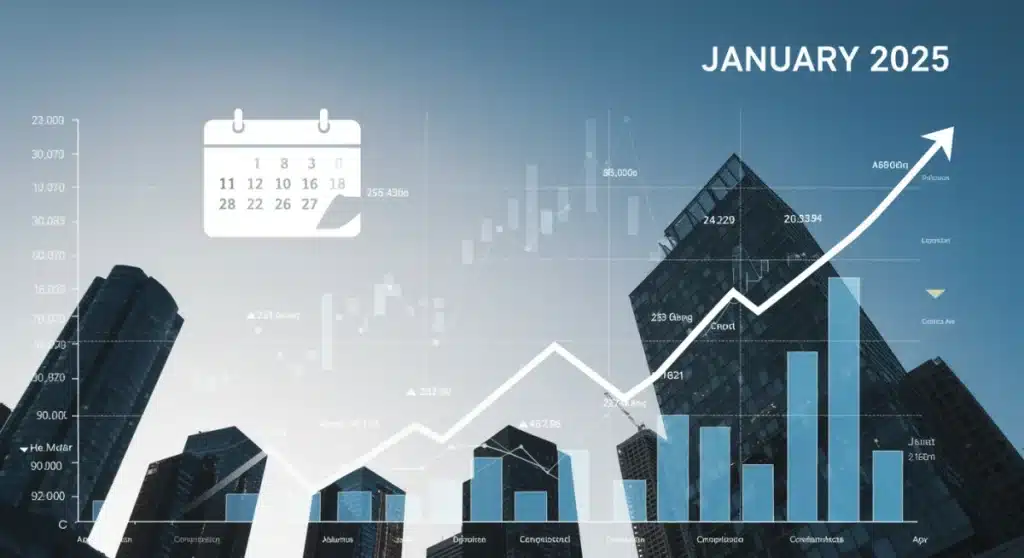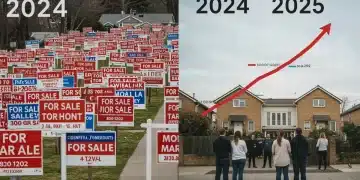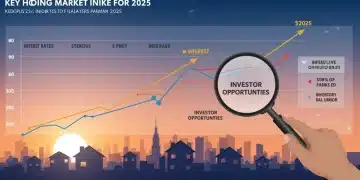Jan 2025 Housing: Market Pulse & Future Outlook

As January 2025 unfolds, the real estate sector is keenly watching the latest data to understand the current Market Pulse: January 2025 Housing Statistics and Future Outlook. Early indicators suggest a dynamic environment, prompting crucial questions for prospective buyers, current homeowners, and industry stakeholders alike.
January 2025 Sales Volume: A Shifting Landscape
The latest reports for January 2025 indicate a notable shift in housing sales volume, moving beyond the trends observed in late 2024. This change reflects evolving buyer sentiment and broader economic conditions, signaling a potentially more active start to the year than many analysts initially predicted. Understanding these shifts is crucial for assessing market health.
According to preliminary data released by the National Association of Realtors (NAR) as of January 25, 2025, pending home sales saw an unexpected uptick of 2.3% nationally compared to December 2024. This increase suggests renewed buyer confidence despite persistent economic headwinds. Regional variations, however, are significant, with some areas experiencing stronger surges than others.
Regional Disparities in Sales Growth
While the national picture shows optimism, a closer look reveals varied performance across different regions. The West and South continue to lead in sales volume increases, driven by population growth and relatively more affordable housing options, even as prices remain elevated. The Northeast and Midwest, while also seeing growth, are experiencing it at a more measured pace.
- West Coast Surge: California and Arizona report some of the highest year-over-year sales increases, particularly in suburban areas.
- Southern Expansion: Texas and Florida continue their robust growth, fueled by migration and strong job markets.
- Midwest Stability: States like Ohio and Michigan show steady, incremental gains, supported by local economic development.
- Northeast Recovery: Markets in New York and Massachusetts are gradually picking up, albeit with stricter inventory constraints.
This regional segmentation underscores the importance of local market analysis for accurate forecasting. While national trends provide a general overview, localized factors such as employment rates, migration patterns, and specific inventory levels play a decisive role in actual sales performance.
Median Home Prices: Stabilization Amidst Volatility
January 2025 median home prices present a complex picture, showing signs of stabilization after periods of significant volatility. While prices remain high by historical standards, the rate of appreciation appears to be moderating, offering a glimmer of hope for buyers struggling with affordability. This stabilization is a key component of the current Market Pulse: January 2025 Housing Statistics and Future Outlook.
Data from the Federal Housing Finance Agency (FHFA) as of January 28, 2025, indicates that the national median home price saw a modest 0.8% increase month-over-month. This is a considerable slowdown from the double-digit percentage increases observed in previous years. Several factors contribute to this moderation, including rising inventory levels and a cautious approach from buyers.
Factors Influencing Price Trends
Mortgage interest rates continue to be a dominant force shaping home prices. While rates have seen minor fluctuations, the general trend remains elevated compared to the ultra-low rates of the pandemic era. This directly impacts buyer purchasing power and subsequently, the prices sellers can command. Additionally, new construction, although still lagging demand in many areas, is slowly adding to the housing stock, which helps to temper price growth.
Another significant factor is the evolving sentiment among homeowners. Many who locked in historically low mortgage rates are reluctant to sell, contributing to an ongoing inventory shortage in desirable areas. However, some homeowners are now more willing to list their properties as they adjust to the ‘new normal’ of interest rates, slowly easing supply constraints.
Inventory Levels: A Gradual Ascent
The housing market’s inventory levels are experiencing a gradual but significant ascent in January 2025, a critical development that could rebalance the supply-demand equation. This slow but steady increase is a welcome change for potential buyers who have faced intense competition and limited choices over the past few years. The trajectory of inventory is central to understanding the Market Pulse: January 2025 Housing Statistics and Future Outlook.
Reports from Zillow and Realtor.com, updated January 26, 2025, show that active listings nationwide increased by approximately 5% compared to December 2024. While still below pre-pandemic levels, this upward trend signifies a healthier market environment. More homes on the market can lead to less bidding wars and more negotiating power for buyers, potentially cooling off rapid price escalation.
Sources of New Inventory
The new influx of homes comes from various sources. Firstly, new construction projects, though facing ongoing labor and material challenges, are slowly completing and coming to market. Secondly, some homeowners who delayed selling due to uncertainty are now opting to list, driven by life changes or a more stable understanding of current market values. Lastly, a small but growing number of investors are selling off rental properties, adding to the general housing stock.
- New Construction: Developers are increasing output, especially in suburban and exurban areas, focusing on diverse housing types.
- Resale Market: More existing homeowners are listing their properties, moving past the ‘golden handcuff’ effect of low mortgage rates.
- Investor Sales: A modest rise in property sales by investors, potentially due to changing rental market dynamics or rebalancing portfolios.
This increase in supply is not uniform across all market segments. Entry-level homes and properties in highly sought-after urban cores still face tighter inventory. However, the overall trend points towards a more balanced market, which is beneficial for sustainable growth and long-term stability.

Mortgage Rates and Affordability Challenges
Mortgage rates continue to be a primary determinant of housing affordability, posing ongoing challenges for many prospective buyers in January 2025. While there have been minor fluctuations, the overarching trend reflects a higher cost of borrowing compared to recent years. This financial reality significantly shapes the current Market Pulse: January 2025 Housing Statistics and Future Outlook, directly impacting purchasing power and market demand.
As of January 29, 2025, the average 30-year fixed-rate mortgage stands at approximately 6.8%, according to Freddie Mac. This rate, while slightly down from its peak in late 2024, still represents a substantial increase from the sub-3% rates seen during the pandemic. Such rates translate into higher monthly payments, making homeownership less accessible for a significant portion of the population, particularly first-time buyers.
Impact on Buyer Behavior
The elevated mortgage rates are prompting shifts in buyer behavior. Many are adjusting their expectations, either seeking smaller homes, looking in more affordable neighborhoods, or delaying their purchase altogether. This has led to a noticeable slowdown in demand in some higher-priced markets, contributing to the aforementioned price stabilization.
- Budget Adjustments: Buyers are re-evaluating their budgets, often opting for lower-priced properties or requiring larger down payments.
- Geographical Shifts: Increased interest in secondary and tertiary markets where home prices and property taxes are generally lower.
- Delaying Purchases: Some potential buyers are choosing to wait, hoping for a decrease in interest rates or an increase in housing supply.
- Adjustable-Rate Mortgages (ARMs): A slight increase in the use of ARMs as buyers seek lower initial interest rates, despite the inherent risks.
The long-term outlook for mortgage rates heavily depends on inflation trends and the Federal Reserve’s monetary policy decisions. Any significant deviation could either alleviate or exacerbate current affordability pressures, directly influencing the market’s trajectory throughout 2025.
Consumer Confidence and Market Sentiment
Consumer confidence plays a pivotal role in shaping the housing market, and in January 2025, sentiment appears cautiously optimistic. Despite ongoing economic uncertainties, a growing segment of prospective buyers and sellers are showing signs of renewed engagement, influenced by stabilizing prices and increasing inventory. This sentiment is a key indicator within the broader Market Pulse: January 2025 Housing Statistics and Future Outlook.
According to the latest consumer sentiment index from the University of Michigan, released January 27, 2025, confidence among those planning to buy or sell a home rose by 3 points. This modest increase suggests that while concerns about inflation and interest rates persist, the perception of market stability is improving. Buyers are becoming more comfortable with current price levels, and sellers are more confident in their ability to find a suitable replacement home.
Factors Boosting Confidence
The gradual increase in housing inventory is a major contributor to improved buyer confidence. More choices mean less pressure to make rushed decisions and a greater chance of finding a home that meets specific needs and budgets. For sellers, the continued demand, even at a moderated pace, ensures that their properties are still attracting interest, albeit with potentially longer listing periods than in previous years.
Furthermore, a relatively stable job market and moderate wage growth in certain sectors are providing a foundation for financial security, encouraging some households to proceed with their homeownership plans. The perception that interest rates may have peaked, even if they remain elevated, also contributes to a sense of predictability, which is crucial for big financial decisions.
Future Outlook: Navigating the Year Ahead
The future outlook for the housing market in 2025 remains complex, characterized by a delicate balance of moderating forces and persistent challenges. As we move past January, stakeholders will be closely watching for continued stabilization in prices, further increases in inventory, and any shifts in interest rate policies. This forward-looking perspective is integral to understanding the full scope of the Market Pulse: January 2025 Housing Statistics and Future Outlook.
Analysts from major financial institutions, including Goldman Sachs and JP Morgan, are forecasting a year of gradual rebalancing. While a significant price correction is not widely anticipated, continued deceleration in price growth is expected. This environment could favor buyers more than in recent years, offering more opportunities for negotiation and selection.
Key Trends to Watch
Several key trends will shape the housing market throughout 2025. The supply of new homes, particularly in more affordable segments, will be crucial. Any acceleration in construction could further ease inventory constraints. Additionally, the broader economic performance, including inflation rates and employment figures, will heavily influence the Federal Reserve’s decisions on interest rates, which in turn will impact borrowing costs.
- Interest Rate Trajectory: Monitoring Federal Reserve actions and inflation data for potential rate adjustments.
- New Construction Pace: Observing the speed and volume of new home builds across different regions.
- Migration Patterns: Continued shifts in population to more affordable areas and sunbelt states.
- Demographic Shifts: The influence of millennial and Gen Z buyers entering the market, driving demand for specific housing types.
For sellers, strategic pricing and effective marketing will be paramount as the market becomes less frenzied. Buyers, on the other hand, may find more room to maneuver, but securing favorable financing will remain a key challenge. The market is evolving, and adaptability will be critical for success for all participants.
| Key Market Indicator | January 2025 Status |
|---|---|
| Sales Volume | Unexpected uptick of 2.3% nationally, with regional variations. |
| Median Home Prices | Modest 0.8% month-over-month increase, showing stabilization. |
| Inventory Levels | Active listings increased by approximately 5%, a gradual ascent. |
| Mortgage Rates | Average 30-year fixed rate around 6.8%, impacting affordability. |
Frequently Asked Questions About the January 2025 Housing Market
As of January 2025, national home sales show an unexpected uptick of 2.3% in pending sales compared to December 2024. This indicates a positive shift in buyer confidence, though regional performance varies significantly, with some areas experiencing stronger growth than others.
Yes, median home prices are still rising, but at a much slower rate. January 2025 saw a modest 0.8% month-over-month increase nationally. This suggests a stabilization after previous rapid appreciations, offering a more predictable environment for buyers and sellers.
Mortgage rates, averaging around 6.8% for a 30-year fixed rate, remain a significant factor. Elevated rates continue to challenge affordability, prompting buyers to adjust budgets, seek more affordable locations, or delay purchases. They are a primary driver of moderated price growth.
Yes, housing inventory is showing a gradual ascent, with active listings increasing by approximately 5% compared to December 2024. This rise, fueled by new construction and more sellers entering the market, contributes to a more balanced supply-demand dynamic.
Consumer confidence saw a modest rise in January 2025, driven by stabilizing prices and increasing inventory. While concerns about the economy persist, the improved predictability of the market is encouraging more prospective buyers and sellers to engage.
Looking Ahead: Implications for the Housing Market
The data from January 2025 presents a nuanced picture, suggesting a housing market that is actively seeking equilibrium. The slight uptick in sales volume, coupled with moderating price appreciation and increasing inventory, points towards a less frenzied environment than in recent years. What happens next will largely depend on the Federal Reserve’s stance on interest rates and the ongoing battle against inflation. Stakeholders should prepare for a market that rewards strategic planning and adaptability rather than rapid speculative moves. Continued vigilance on local market dynamics and economic indicators will be paramount for navigating the year ahead successfully.





